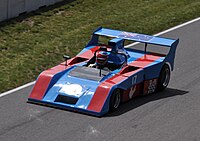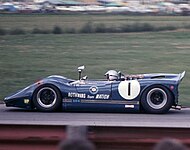
Brabham is the common name for Motor Racing Developments Ltd., a British racing car manufacturer and Formula One racing team. Founded in 1960 by Australian driver Jack Brabham and British-Australian designer Ron Tauranac the team won four Drivers' and two Constructors' World Championships in its 30-year Formula One history. Jack Brabham's 1966 FIA Drivers' Championship remains the only such achievement using a car bearing the driver's own name.

Repco is an Australian automotive engineering/retailer company. Its name is an abbreviation of Replacement Parts Company and it is best known for spare parts and motor accessories.

Vernon John Schuppan is a retired Australian motor racing driver. Schuppan drove in various categories, participating in Formula One, the Indianapolis 500 and most successfully in sports car racing.

Formula 5000 was an open wheel, single seater auto-racing formula that ran in different series in various regions around the world from 1968 to 1982. It was originally intended as a low-cost series aimed at open-wheel racing cars that no longer fit into any particular formula. The '5000' denomination comes from the maximum 5.0 litre engine capacity allowed in the cars, although many cars ran with smaller engines. Manufacturers included McLaren, Eagle, March, Lola, Lotus, Elfin, Matich and Chevron.
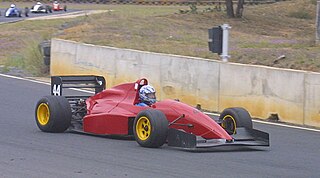
Formula Holden was an Australian open wheel racing category introduced in 1989.

Ralt was a manufacturer of single-seater racing cars, founded by ex-Jack Brabham associate Ron Tauranac after he sold out his interest in Brabham to Bernie Ecclestone. Ron and his brother had built some specials in Australia in the 1950s under the Ralt name. Tauranac won the 1954 NSW Hillclimb Championship in the Ralt 500.
John GossOAM is an Australian retired motor racing driver who competed in his home country during the 1960s, 1970's and 1980's. He is the only driver to have won Australia's two most prestigious races, the Bathurst 1000, and the Australian Grand Prix (1976).

The Brabham BT19 is a Formula One racing car designed by Ron Tauranac for the British Brabham team. The BT19 competed in the 1966 and 1967 Formula One World Championships and was used by Australian driver Jack Brabham to win his third World Championship in 1966. The BT19, which Brabham referred to as his "Old Nail", was the first car bearing its driver's name to win a World Championship race.
The 1975 Australian Drivers' Championship was a CAMS sanctioned Australian motor racing title open to Australian Formula 1 cars and Australian Formula 2 cars. The championship winner was awarded the 1975 CAMS "Gold Star". The title, which was the nineteenth Australian Drivers' Championship, was won by John McCormack driving an Elfin MR6 Repco-Holden.
The 1964 Tasman Series was an international motor racing series contested in New Zealand and Australia over eight races beginning on 4 January and ending on 2 March. It was the first Tasman Series. The series, which was officially known as the Tasman Championship for Drivers, was organised jointly by the Association of New Zealand Car Clubs Inc. and the Confederation of Australian Motor Sport with the winning driver awarded the Tasman Cup. The championship was open to racing cars using unsupercharged engines of up to 2,500 c.c. capacity.
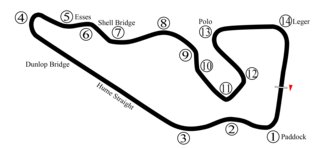
Warwick Farm Raceway was a motor racing facility which was in operation from 1960 to 1973. Warwick Farm Raceway hosted numerous major events during its life such as the Australian Grand Prix and rounds of both the Australian Touring Car Championship and the Tasman Series.

Shrike is a racing car developed in Australia by the students of the Croydon Park Institute of TAFE in Adelaide in 1988 and 1989. It was developed for the then new Formula Holden category which mandated an aluminium tub monocoque, powered by a Buick sourced 3.8 litre Holden V6 engine, as used in the Holden VN Commodore at that time. The car proved to be instantly competitive in the Australian Drivers' Championship against designs from Elfin, Cheetah, and imported Formula 3000 chassis such as Ralt and Reynard.
The 1972 Australian Grand Prix was a motor race for cars complying with the Tasman Formula, which admitted both Formula 5000 and 2-litre racing cars. The race, which was held at Sandown International Raceway on 20 February 1972, had 19 starters.
The 1964 Australian Grand Prix was a motor race held at the Sandown Park circuit in suburban Melbourne, Victoria, Australia on 9 February 1964. It was the twenty ninth Australian Grand Prix and was also Round 5 of the 1964 Tasman Series and Round 1 of the 1964 Australian Drivers' Championship. The race was open to Racing Cars complying with the Australian National Formula or the Australian 1½ Litre Formula.

The 1968 Australian Grand Prix was a motor race held at Sandown Park in Victoria, Australia on 25 February 1968. The race was open to Racing Cars complying with the Australian National Formula or the Australian 1½ Litre Formula. It was the thirty third Australian Grand Prix and was also round seven of the 1968 Tasman Series. The race was staged by the Light Car Club of Australia and was sponsored by the Royal Automobile Club of Victoria.
The 1976 Australian Grand Prix was a motor race held at the Sandown International Motor Racing Circuit in Victoria, Australia on 12 September 1976. It was open to racing cars complying with either Australian Formula 1 or Australian Formula 2.
Briggs Motor Sport was an Australian motor racing team which has represented Queensland based businessman John Briggs in motor racing. The team has competed in Sports Sedans, Australian GT, Formula Holden, and most notably as a touring car team competing in the V8 Supercar Championship Series. The team last competed in historic motor racing and the Australian GT Championship but was folded at the end of the 2009 season.
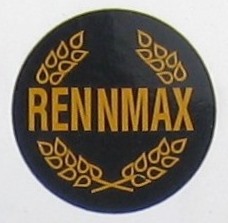
The Rennmax name was applied to a series of open wheel racing cars and sports racing cars constructed by Rennmax Engineering in Sydney, Australia between 1962 and 1978. Rennmax Engineering was established by Bob Britton in 1961, its name derived from the German word "Renn", meaning race and the abbreviation "max", for maximum.
The 1971 Australian Drivers’ Championship was a CAMS sanctioned motor racing title open to Australian Formula 1 and Australian Formula 2 racing cars. It was the fifteenth Australian Drivers' Championship and the first to feature cars complying with a new for 1971 Australian Formula 1 which permitted cars with production based V8 engines of up to 5 litre capacity or racing engines of up to eight cylinders and up to 2 litre capacity. The championship winner was awarded the 1971 CAMS Gold Star and the title of Australian Champion Driver.
The Mildren name was used on a series of racing vehicles constructed for, or acquired by, Australian racing team owner Alec Mildren during the 1960s and early 1970s.

